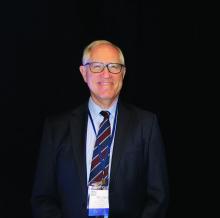LOS ANGELES – , according to the best available data.
In addition, there does not seem to be a floor of achieved LDL-C levels where cardiovascular outcomes are not decreased.
Those are two key lessons from recent trials of PCSK9 inhibitors that Norman E. Lepor, MD, highlighted at the World Congress on Insulin Resistance, Diabetes & Cardiovascular Disease. Anti-PCSK9 antibodies have shown a significant lipid-lowering effect, lowering LDL-C by 45%-55% from baseline regardless of whether patients are on statins or ezetimibe. More than 70% of high-risk patients are able to achieve an LDL-C level less than 70 mg/dL.
In two randomized trials known as SPIRE-1 and SPIRE-2, researchers compared the PCSK9 inhibitor bococizumab with placebo (N Engl J Med 2017;376:1527-39). The main difference between these two trials was the baseline cardiovascular risk was higher in SPIRE-2, particularly the baseline LDL levels. “Both trials were stopped early because of the increased incidence of antibodies against bococizumab as well as adverse events associated with that, particularly injection site reactions,” said Dr. Lepor, a cardiologist who is professor of medicine at the Geffen School of Medicine at UCLA.
SPIRE-1 did not show a significant difference within a short time of that trial, but SPIRE-2 showed a profound reduction in cardiovascular events within a short time. “That led to the conclusion that the higher the LDL, the higher risk you are, the more likely that you’re going to attain a more robust reduction of cardiovascular events,” Dr. Lepor said. Bococizumab, a partially humanized antibody, did not come to market because of the high incidence of anti-drug antibody and associated diminution of therapeutic effect, he added.
Next came the FOURIER trial of evolocumab, a randomized, double-blind, placebo-controlled trial involving 27,564 patients with atherosclerotic cardiovascular disease and LDL cholesterol levels of 70 mg/dL or higher who were receiving statin therapy. Study participants received evolocumab (either 140 mg every 2 weeks or 420 mg monthly) or matching placebo as subcutaneous injections (N Engl J Med. 2017;376:1713-22). “The reduction in LDL was very robust and occurred quite early, and there was consistency in terms of long-term effect,” said Dr. Lepor, a past president of the California chapter of the American College of Cardiology. Specifically, researchers observed a 15% reduction in the primary endpoints of a composite of cardiovascular death, MI, stroke, hospitalization for unstable angina, or coronary revascularization (P less than .001), and a 20% reduction in the key secondary endpoints of a composite of cardiovascular death, MI, or stroke.
“It’s important to note that these are patients who were already well treated on statins,” he said. “There really does not seem to be a floor of LDL levels where we can say there is no further benefit. Achieved LDL-C at 4 weeks did lead to the ability to prognosticate benefit. We’re not seeing an increase in situations like diabetes, neurocognitive effects, and myalgias. The incidence of adverse events are similar to placebo. We feel very good that there do not seem to be safety issues for these agents, particularly in a population of patients with very low LDLs.” Dr. Lepor went on to note that FOURIER substudies have shown that there did not seem to be any increased incidence of neurocognitive disorders in patients taking evolocumab and that diabetes “tends to be a disease amplifier.”
In a more recent trial known as ODYSSEY OUTCOMES, 18,536 acute coronary syndrome (ACS) patients were randomized to alirocumab 75 mg once every 2 weeks or placebo (N Engl J Med. 2018;379:2097-107). The dose of alirocumab was increased to 150 mg every 2 weeks if the LDL was not lowered to less than 50 mg/dL. “The trial had other interesting aspects to it,” Dr. Lepor said. “If you had an LDL during the trial of less than 25 mg/dL, you were down-titrated from the 150-mg dose to the 75-mg dose, or if you were on the 75-mg dose with two consecutive LDLs less than 15 mg/dL, the alirocumab was stopped, all in blinded fashion.” The primary outcome was time to first occurrence of CHD death, nonfatal MI, ischemic stroke, or hospitalization for unstable angina.
At baseline, patients had a median age of 58 years, 25% were women, their median LDL was 92 mg/dL. About 89% of patients were on high dose atorvastatin/rosuvastatin. Time from index ACS to randomization was a median of 2.6 months.
The primary efficacy endpoint was major adverse cardiac events including CHD death, nonfatal MI, ischemic stroke, or unstable angina requiring hospitalization. After a median follow-up of 2.8 years, the researchers observed highly significant 15% reduction of the primary endpoint with alirocumab compared with placebo (hazard ratio, 0.85; P = .0001), and a 15% reduction of death from any cause. In patients with a baseline LDL-C of 100 mg/dL or greater, the benefits of alirocumab were further amplified. “The higher your LDL, the higher your risk,” Dr. Lepor said. “The higher your risk, the greater your benefit from therapeutic intervention.”
He concluded his presentation by likening the treatment approach with PCSK9 inhibitors in ACS patients to that of chemotherapy in cancer patients. “In patients who have the very high risk of recurrence, those are the ones we want to attack with tougher chemotherapy,” he said. “Who are the patients who benefit most from PCSK9 inhibitors? ACS patients and those who are breaking through statin therapy with cardiovascular events, those with diabetes, CKD, and peripheral vascular disease.”
Dr. Lepor disclosed that he serves on the advisory board for Sanofi/Regeneron and is on the speakers bureau for Amgen and Sanofi/Regeneron.


